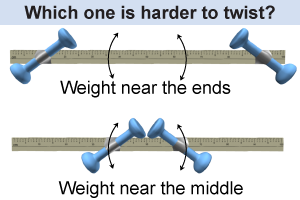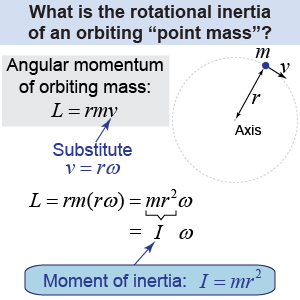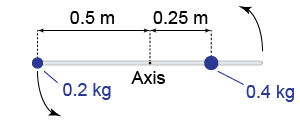|
 Newton’s first law says that an object at rest remains at rest and an object in motion remains in motion with the same velocity when the net external force is zero. The rotational analogy to Newton’s first law involves rotational inertia, angular velocity, and torque:
Newton’s first law says that an object at rest remains at rest and an object in motion remains in motion with the same velocity when the net external force is zero. The rotational analogy to Newton’s first law involves rotational inertia, angular velocity, and torque:
When the net torque is zero, an object at rest remains
at rest and a rotating object continues to rotate
at the same angular velocity. Attach two dumbbells to a meter rule. Is it harder to twist the weighted ruler if the dumbbells are located close to the center or at the ends? When the dumbbells are located near the ends, the weighted ruler has a larger moment of inertia—or more rotational inertia—which means that it is more difficult to twist. Moment of inertia is an important quantity in rotational dynamics. It helps us answers questions such as whether a sphere or a cylinder (with equal radii) will roll downhill faster. 
|
Moment of inertia
|
 In the previous section, we learned about the rotational inertia of a Ferris wheel. The moment of inertia of an object is a measurement of its resistance to changes in its rotational state. Moment of inertia I is calculated as the product of mass times the square of the distance from the rotational axis, and the term is often used interchangeably with “rotational inertia.” The moment of inertia depends strongly on how far the mass is located from the axis of rotation, because I depends on r2. If you move the mass twice the distance from the axis, the moment of inertia increases by a factor of 4! Since the equation for moment of inertia is I = mr2, its units are kg m2.
In the previous section, we learned about the rotational inertia of a Ferris wheel. The moment of inertia of an object is a measurement of its resistance to changes in its rotational state. Moment of inertia I is calculated as the product of mass times the square of the distance from the rotational axis, and the term is often used interchangeably with “rotational inertia.” The moment of inertia depends strongly on how far the mass is located from the axis of rotation, because I depends on r2. If you move the mass twice the distance from the axis, the moment of inertia increases by a factor of 4! Since the equation for moment of inertia is I = mr2, its units are kg m2. 
|
Think back to the example of the rotational inertia of a Ferris wheel on page 365. A large wheel has more rotational inertia, because moment of inertia I is directly proportional to the square of the radius r in equation (13.1). A massive wheel also has more rotational inertia, because I is proportional to mass m in equation (13.1). 
|
What is the moment of inertia of two masses (in the figure at right) as they rotate about the center of a massless rod? | Asked: | combined moment of inertia I | | Given: | masses m1 = 0.2 kg and m2 = 0.4 kg;
radii r1 = 0.5 m and r2 = 0.25 m | | Relationships: | moment of inertia I = mr2 | | Solution: | | |  | 
|
Inertia depends on mass. Rotational inertia, however, depends on something in addition to mass. What is it?
 |
Rotational inertia or the moment of inertia depends on distance from the axis of rotation in addition to mass. 
|

